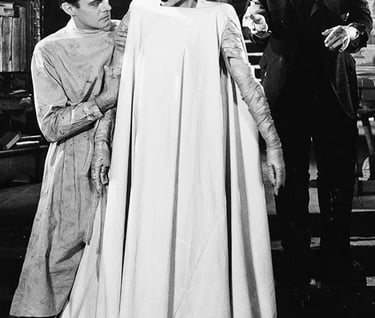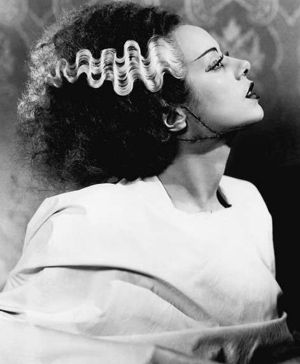The Bride of Frankenstein (1935)
“It's a perfect night for mystery and horror. The air itself is filled with monsters.” – Mary Wollstonecraft Shelley


The year was 1935, and Universal produced one of the most celebrated horror movies to ever creep out of Hollywood’s crypt. Bride of Frankenstein was the first sequel to the Universal’s ever-growing horror line-up (many more of varying quality would follow over the years, wait and see) and is that rarity – a sequel that is superior in every way to the original. And let’s be honest, the original Frankenstein set the bar pretty high.
This sequel was planned soon after Frankenstein’s release in 1931, but there were script problems, James Whale, Universal’s hotshot director, didn’t want to direct a sequel, casting problems – Colin Clive, a nervous alcoholic was succumbing to his demons badly. Mae Clarke who had played Elizabeth had severe health problems and couldn’t work.
Whale was eventually lured back and created his masterpiece. Clive resumed his role of Henry Frankenstein because the director needed his unique level of hysteria, and Clarke was replaced by seventeen-year-old English actress Valerie Hobson. There was never a question of replacing the mighty Boris Karloff, billed again as simply “Karloff”, as the monster.
The film has a unique and instantly recognisable quirky score by Franz Waxman that comprises of three distinct themes, one for the monster, one for Dr Pretorius and one for the Bride and was later reused in Universal’s movie serials Flash Gordon’s Trip to Mars and Buck Rogers.
It introduced fans to a new iconic monster in the Bride, though like Karloff’s equally iconic Mummy (1932) she only appears on screen for around three minutes. But it made actress Elsa Lanchester the screen’s first Scream Queen.
The film opens with a prologue featuring Lord Byron, Percy Shelly and his wife Mary, (in a typical Whale twist, Mary is ALSO played by Elsa Lanchester) an elegant trio discussing Mary’s tale of horror, Frankenstein, giving a quick reprise of the event of the first film. Mary reveals that the story didn’t end at the burning windmill.
The opening of the film is a little at odds with what we saw at the end of Frankenstein, in that Henry is presumed dead after being thrown from the windmill by the Monster, and “Little Maria” who was drowned in the original has new parents with different names, but the crowd scene allows the introduction of a few of Whale’s stock company of character actors. Among them are old favourites from The Invisible Man, Una O’Connor as the ever shrill, shrieking harpy of a maid, Minnie and E.E. Clive playing another pompous but comically ineffective official, the Burgomaster.
But the Monster isn’t dead, he has crashed through the wooden flooring to a flooded pit beneath. The same happens to the curious Hans, father of the drowned little girl from the first film who wants to make sure the Monster has indeed burnt to a crisp and meets an all too alive and angry Karloff.
Karloff’s make-up by Jack Pierce is ingenious. Basically, the same as before, but his hair has been singed back and he’s displaying some severe burns. Over the course of the film, the make-up is subtly changed to show the hair growing back and the burns healing as the skin regenerates.
Dispatching of both Hans and his wife and scaring the living daylights out of Minnie, we join Henry and Elizabeth at their castle. Understandably, Elizabeth is a nervous wreck and succumbs to a hysteria attack when the decidedly odd Dr Septimus Pretorius (Ernest Thesiger) pays a visit.
Pretorius is Frankenstein’s old teacher (Whatever happened to Waldman being his teacher?) and wants to show off his own experiments. He too wants to create life, but has grown his like cultures with strange results. They’re all about eight inches tall and live in jars – including a mermaid, “an experiment with seaweed”.
Pretorius wants to partner with Henry to create a woman. Wisely, Henry wants none of it. Kind of “been there, bought the t-shirt” deal.
Back to the Monster, who is wandering around the countryside, he accidentally scares the hell out of a shepherdess, and is caught by the authorities in mock crucifixion scene before being taken into custody by the angry mob led by the Burgomaster but they cant hold him for long before he’s rampaging again – and here’s where we get a weird little scene that goes nowhere.
A murdered little girl’s body is found, as well as those of an elderly couple in their home. This was intended as a sub plot with the culprit being Frankenstein’s lab assistant, Karl (Dwight Frye). The revelation was removed at the censor’s insistence leaving the implication that the Monster did it, or worse… The fleeing Monster stumbles on to the gypsy camp in a hastily filmed extra scene filmed just before release. I really don’t know if this was meant to imply that the gypsies were responsible for the crimes to keep the Monster as essentially a sympathetic character.
This sympathetic character is reinforced with the Monster’s encounter with a blind hermit, who takes him in before a couple of lost hunters discover the Monster and start shooting, so the Monster escapes into a cemetery where he avoids the angry mob by accidentally discovering an underground crypt and hiding there – where he happens to meet Pretorius.
Pretorius teaches the Monster a few rudimentary words (a move Karloff resisted) and uses his new friend to sway Henry into helping him. For added pressure, the monster also kidnaps Elizabeth and holds her ransom until his bride is built.
The night the Bride comes to life is one of the best laboratory scenes ever, with the shots of the lightning hitting the kites flown from the towers down to the suspended surgical bed where the Bride’s body rests.
As she’s brought down and her recently installed heart beats, she’s unveiled as a bandage clad woman, wearing a long white surgical gown as a bridal veil to a weird wedding bell soundtrack.
Her make-up is basically that of a Hollywood glamour queen with a scar under her chin, across her throat and that bizarre electrified beehive. Poor Elsa Lanchester had to stand on stilts to bring her up to seven feet tall. In reality, she was 5’4.


When the Monster sees his Bride, he approaches her slowly, inquiring “friend…?” and tenderly takes her hand, but she rejects him, staggering in the direction of Henry.
As Elizabeth has somehow escaped and made her way to the lab and is hammering on the door, the Monster, with a tear rolling down his cheek, allows Henry to escape with her before pulling the lever that blows the whole place up with a sad “We belong dead”.
Truly one of the films that made me a horror fan way back in my early teens.
